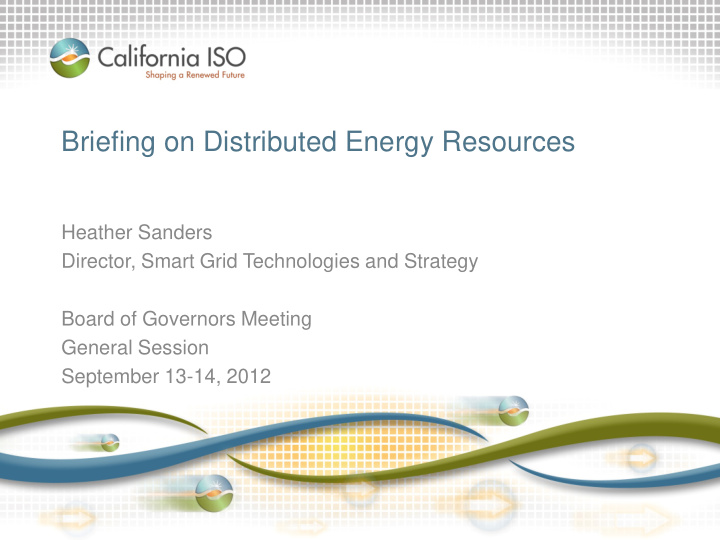



Briefing on Distributed Energy Resources Heather Sanders Director, Smart Grid Technologies and Strategy Board of Governors Meeting General Session September 13-14, 2012
Distributed generation, demand-side resources and emerging technologies are changing the landscape of California’s electric grid. • Change driven by consumer and State environmental goals • Resources can provide ISO benefits – Ramping Sample winter – Load following day in 2020 • Challenges to significant participation • The ISO is heavily engaged and committed to developing distributed energy resources Slide 2
A number of complex issues need to be resolved to enable significant implementation and penetration of distributed energy resources. • This presentation covers major themes across distributed energy Distributed Generation resource types • It highlights key issues and ISO activities for each resource type Demand Response Energy Storage Electric Vehicles Slide 3
There are several themes consistent across distributed energy resource types. • Lack of visibility and experience • Lack of revenue sufficiency • Ability to access to the ISO markets • Availability of metering and telemetry options Slide 4
Distributed generation with adequate visibility will reduce reserve requirements. • Over 1,200 MW of solar PV is installed in California that is not visible to the ISO. • This amount will increase driven by consumer and policy drivers and incentives. • Visibility is needed to support forecasting and the most cost-effective unit commitment. Slide 5
Distributed generation with adequate visibility will reduce reserve requirements. • ISO activities supporting distributed generation include: – Defined visibility requirements for distributed generation resources not participating in the ISO market; – Developing a process to receive periodic updates of distributed generation connecting to the grid; – Reviewing metering and telemetry requirements and options for cost-effectiveness. – Engaging in California Public Utilities Commission interconnection proceeding with reserve requirements; – Implementing board approved process for deliverability assessments for local generation; and – Reviewing must offer obligation for resources receiving resource adequacy status. Slide 6
Demand-side resource participation in the ISO market is primarily constrained by regulatory policy. • Less than 3 MW of the over 2,300 MW of utility demand response programs are bid into the ISO market. ISO market response ~ 3 MW • Resolution of multiple regulatory items is Voluntary calls ~ needed including: 1,000 MW – Wholesale market compensation; Utility programs ~ 2,300 MW – Restrictions on direct participation; (bulk are emergency only) – Insufficient revenue opportunities; – Lack of price signals; and – Need for metering and telemetry options. • High cost estimates from IOUs to bring demand response into ISO market • Demand response program and resource capability need alignment with ISO requirements and grid conditions. Slide 7
Demand-side resource participation in the ISO market is primarily constrained by regulatory policy. • ISO activities supporting demand response include: – Engaging in California Public Utilities Commission demand response related proceedings; – Working through the Federal process for wholesale market compensation; – Implementing market policy providing comparable treatment and revenue opportunities; – Planning pilots to understand end-use capabilities and provide input to policy decisions; and – Reviewing metering and telemetry requirements and options for cost- effectiveness and options to support data concentration. Slide 8
Energy storage resources need better operational understanding and face similar regulatory barriers as demand response. • Limited experience with new energy storage technologies • Regulatory issues that need to be resolved include: – Restrictions in the WECC standard for provision of ancillary services; – Restrictions on direct participation; – Insufficient revenue opportunities; – Lack of price signals; and – Need for measurement and verification options. PG&E Vaca-Dixon Battery Installation Slide 9
Energy storage resources need better operational understanding and face similar regulatory barriers as demand response. • ISO activities – Executing technology pilots to understand operational capabilities; – Clarifying with the Federal Energy Regulatory Commission that batteries are eligible to provide ancillary services; – Developing market policy providing pay for performance; – Implementing market model to support energy storage; and – Reviewing metering and telemetry requirements and options for cost-effectiveness. Slide 10
Electric vehicles aggregation is in an early stage technically with needed policy waivers to pilot vehicle- to-grid capability. • Executive order for zero-emission vehicles establishes vehicle V2 G Model infrastructure readiness goals. Aggregator • CPUC settlement with NRG contributes over $100 million to Charging Grid Vehicle enable infrastructure. Station • Managing “smart” charging needs Charging Vehicle to be in developed. Station • Policy waivers related to direct participation in ISO market, retail rate treatment, sub-metering, etc. • Future electric vehicle rate structures need to consider expected load shape changes and grid flexibility needs. Slide 11
Electric vehicles aggregation is in an early stage technically with needed policy waivers to pilot vehicle- to-grid capability. • ISO activities supporting vehicle-to-grid include: – Pilot project with the Department of Defense at the Los Angeles Air Force base; – Leadership role in the development of vehicle-to-grid roadmap for the Governor’s office zero emission vehicle action plan; and – Engaging in California Public Utilities Commission electric vehicle proceeding. Slide 12
Combining distributed energy resources to form microgrids, virtual power plants, or community choice aggregations will become more prevalent. • End-use consumers optimize resources taking control of energy use and seek additional revenue streams. • Microgrids include co-located resources and load and can separate from the electric grid. • Virtual Power Plants aggregate University of California, San Diego resources across a larger area. • The ISO is working with the University of California San Diego to understand the capabilities of their microgrid. Slide 13
To realize the benefits of distributed energy resources while maintaining the integrity of ISO core functions we need to: • Understand and prove the value of distributed energy resource participation in the ISO market; • Advance development of new market products and services; • Evolve regulatory policy for interconnection and participation; and • Enable more cost-effective metering and telemetry solutions. Slide 14
Recommend
More recommend